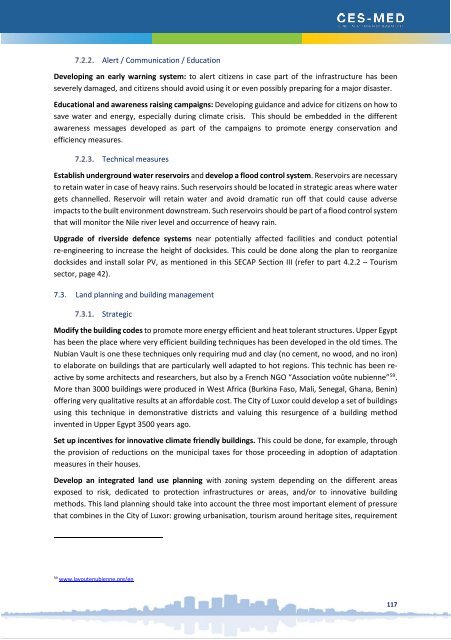130218_Luxor-Egypt SECAP Final
Create successful ePaper yourself
Turn your PDF publications into a flip-book with our unique Google optimized e-Paper software.
esult of a partnership between <strong>Egypt</strong> and the Millennium Development Goals Achievement Fund<br />
(MDGAF). The CCRMP has three main objectives to:<br />
• Integrate GHG mitigation into national policy and investment frameworks;<br />
• Increase climate change adaptation capacities, particularly in agriculture and water;<br />
• Raise awareness regarding the impacts of climate change 59 .<br />
Key achievements that came out of such joint programme are to successfully assist in and support the<br />
establishment of the following units and capacity building:<br />
• Clean Development Mechanism Awareness & Promotion Unit (CDMAPU) within EEAA,<br />
• Energy Efficiency Unit (EEU) that advises the Cabinet on energy efficiency,<br />
• The MoWRI’s capabilities to forecast climate change scenarios, and<br />
• The irrigation research and climate change crop simulation activities of the Ministry of<br />
Acclamation of Land Resources (MALR).<br />
Further to the SNC to UNFCCC, <strong>Egypt</strong> published in 2010 a National Environmental, Economic and<br />
Development Study (NEEDS) for CC to outline the financial and institutional needs for implementing<br />
prospective and on-going adaptation and mitigation measures. This study recognizes that the next<br />
phases of CC planning should include a National Action Plan for Adaptation (NAPA) and National Low<br />
Carbon Economy Plan (NLCEP). The NEEDS report highlights the urgency for developing a GHG<br />
monitoring system that aggregates and disseminates information about GHG emissions across sectors.<br />
6.2. Adopted Measures within the framework of the INDCs<br />
There are national efforts, which have been realized in the adaptation and mitigation. <strong>Egypt</strong>'s<br />
adaptation efforts can be outlined as per the INDCs 2015 as follows:<br />
Adaptation Challenges<br />
The vulnerability of <strong>Egypt</strong>'s water resources to climate change depends on Nile flows, rainfall, and<br />
ground water.<br />
Agricultural sector<br />
Climate change studies expect that the productivity of two major crops in <strong>Egypt</strong> - wheat and maize –<br />
will be reduced by 15% and 19%, respectively, by 2050. Losses in crop productivity are mainly<br />
attributed to frequent temperature increase, irrigation water deficit, and pests and plant disease. In<br />
addition, 12% to 15% of the most fertile arable land in Nile Delta is negatively affected by sea level rise<br />
and salt water intrusion. In terms of livestock production, current evidence shows that temperature<br />
rise leads to harmful heat stress, which negatively impacts livestock productivity. New animal diseases<br />
have emerged in <strong>Egypt</strong>, which have strong negative impacts on livestock production. These include<br />
bluetongue disease and rift valley fever, which are both attributed to significant changes in the<br />
<strong>Egypt</strong>ian climate. Climate change is expected to increase seawater temperature, shifting fish<br />
distributions northwards to live in deeper waters. In addition, increased water salinity in the coastal<br />
lakes in <strong>Egypt</strong> is expected to negatively affect fish species.<br />
Coastal zones<br />
Costal zones are expected to suffer from climate change direct impacts. These include sea level rise<br />
and the overflow of low-level land. Estimations indicate that sea level rise by 50 cm leads to serious<br />
111

















